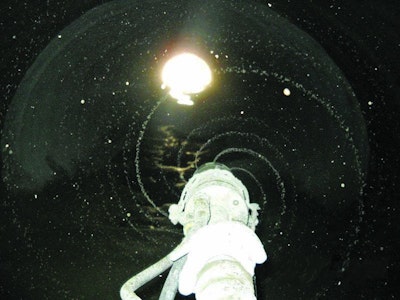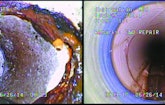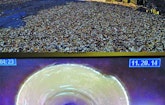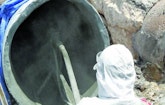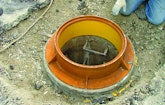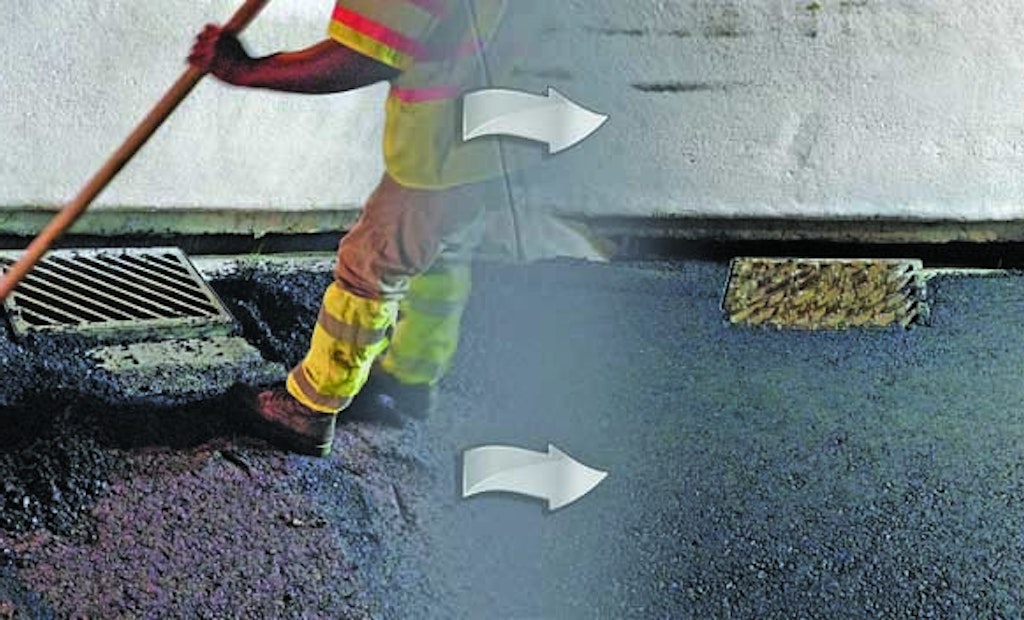Interested in Manholes?
Get Manholes articles, news and videos right in your inbox! Sign up now.
Manholes + Get AlertsGrate risers speed along median work
Problem: Curtis Contracting was hired to rehabilitate 250 large median inlet grates (20- by 30-inch and 30- by 30-inch, with grates weighing 80 to 90 and 150 pounds) in Virginia. The rehabilitation featured multiple asphalt lifts totaling up to 6.5 inches of new pavement. Since federal and state highway safety specifications called for no more than a 2-inch differential between pavement and other surfaces at any time, CCI was looking at raising 250 inlet grates multiple times during the course of the work. Raising them conventionally by excavating and installing new concrete rims would have been expensive, labor-intensive and time-consuming. Due to all the asphalt removal and replacement, the work would have degraded the overall quality of the rehabilitation and could have led to additional lane closures.
Solution: “We heard about this method at a project meeting,” says Assistant Project Manager Kirill Gorin. “A team member suggested inlet grate risers fabricated by American Highway Products. We looked into it and decided they would work well for the almost 250 median grates we would be dealing with.”
Result: “These risers are cost-effective and easy to install. Ultimately, various thicknesses of risers (which can be as thin as 3/4 inch) gave us the option of adequately adjusting the height of the grate without creating a hazard,” says Gorin. “Too high would not allow water to enter the grate and too low (2 inches below grade) is considered hazardous to the traveling public. We’re more than halfway through the project now, have installed hundreds already, and they’re working out very well.” 888/272-2397; www.ahp1.com.
City saves failing road with CCCP
Problem: When a two-lane paved road in Jerseyville, Illinois, was failing, City Engineer Robert Kincaid discovered a 60-inch by 100-foot-long CMP sewer was in very bad shape. The road was slumping due to a wide gap near the middle of the sewer run where sections were out of horizontal alignment by about 8 inches. Limited staging areas made trench-and-replace costly and inconvenient, and CIPP was ruled out due to the large pipe diameter.
Solution: Kincaid suggested CentriPipe, a centrifugally cast concrete pipe (CCCP) trenchless solution from AP/M Permaform. Using a precisely controlled spincaster pulled through the pipe, the system applies PL-8000 high-strength cementitious grout in thin, even layers, creating a new, structurally sound concrete pipe within the old pipe while requiring a very minimal staging area. Ace Pipe Cleaning discovered that seasonal flows had obscured a 3-foot-deep trench along 40 to 50 feet of the sewer bottom. The eroded trench was filled with 10 cubic yards of diggable fill and topped with a few inches of sprayed and troweled PL-8000. The 8-inch gap was then filled and beveled to make an even transition. After dewatering with coffer dams and a 2-inch pump, the pipe was cleaned and two 3/4-inch layers of PL-8000 were applied in two days.
Result: Two walkthroughs in the first four months following installation, once after a major rain event, have shown the work to be holding up perfectly. 800/662-6465; www.centripipe.com.
Stormwater filter fits in tight building footprint
Problem: A developer of a high-rise LEED Gold-certified building located in downtown Vancouver, British Columbia, needed to treat stormwater runoff within a small footprint.
Solution: Engineers chose the lightweight, compact fiberglass Jellyfish Filter system from Filamat Composites to achieve the water-quality goals and obtain a LEED credit. The filter is composed of high surface area membrane cartridges, which provide 89 percent of TSS removal, and a high percentage of particulate-bound pollutants, including phosphorus, metals, turbidity and hydrocarbons. Working with the project team, Imbrium’s engineering staff designed a 4-foot-diameter filter constructed from fiberglass, which was then suspended in free headspace within the building footprint. Suspending the lightweight fiberglass filter from a platform in free headspace within the building’s parking lot resulted in zero loss of parking space and maximized the real estate value while protecting the environment.
Result: This compact, above-grade stormwater quality treatment solution allowed the team to satisfy all the design requirements, provide a high level of stormwater quality treatment, and contribute toward the building’s LEED certification. 866/387-8236; www.filamat.com.
Polymer concrete manhole withstands bacterial corrosion
Problem: Salt Lake City in Utah had a manhole corrosion and infiltration problem created by a sulfur hot spring with high water temperature, high water levels and heavy Thiobacillus bacteria growth. The concrete manhole was previously coated and failed again in a short period of time. The high sulfur content and hot water temperatures in the springs increased the bacteria colony growth to the point that joint and wall corrosion was causing unacceptable infiltration. The city considered recoating or an internal sleeve and decided against both options, as the exact condition of the original structure was suspect.
Solution: Project Manager Blaine Raby chose to install an Armorock polymer concrete manhole from Geneva Polymer Products. “I wanted a product that I knew wouldn’t corrode and was structural and rigid. Then my only concerns were buoyancy and joint infiltration. The manufacturer provided a ballast slab on the precast base section to alleviate my buoyancy concerns, and I called for both a gasketed and mastic joint. Extensive installation problems were created by excessive groundwater, excavation and dewatering. Stacking the manhole was the easy part. The project was completed in four days.”
Result: An ongoing-problem manhole was replaced with a sustainable structure designed specifically for adverse acidic conditions. The city is warranted for 50 years on corrosion, and may get as much as a 100-year life span on a manhole that was having difficulty making it 10 years between rehabilitations. 801/376-9171; www.genevapolymerproducts.com.
Point repair system used to restore defective truss pipe
Problem: Mid-Mo Environmental of Jefferson City, Missouri, was cleaning and televising an 8-inch reinforced truss pipe for Callaway County and found it needed repairs for three defects — a lateral crack, an abandoned tap and a bad joint — all within a 6-foot-2-inch span, causing severe I&I issues. As with many of these lines, it was under a street and buried in excess of 10 feet deep.
Solution: Shawn York, owner and certified installer of the Infrastructure Trenchless Point Repair System from Infrastructure Repair Systems, made the decision to restore the three defective areas with a single 7-foot infrastructure point repair liner. Since the damaged area was within 24 feet of the manhole, he devised a 3/4-inch PVC pushrod and pushed the flow-through carrier wrapped with the resin-soaked 7-foot structural fiberglass and felt liner into position to cover all three damaged areas.
Result: Mid Mo’s use of the trenchless, single 7-foot repair to cover all three damaged areas saved Callaway County thousands of dollars. Digging and replacing could have taken weeks, and three individual point repairs would have taken one to two days. With the IRSI single point repair there was no disruption of service to customers or the environment. This successful permanent repair was completed in less than three hours. 877/327-4216; www.irsi.net.
Point repair leads to significant cost and time savings
Problem: In Mayfield, Kentucky, a 10-inch vitrified clay pipe was missing a 4-foot section, causing massive amounts of continuous I&I. A small, concrete bridge with an 18-inch storm drain crossing the sewer line sat above the pipe. Traditional dig-and-replace methods would have forced the city to bypass both sewer lines, completely rebuild the bridge and close the road, with estimated costs between $25,000 and $30,000.
Solution: The city, hoping to avoid a long and expensive excavation, turned to Source One Environmental to provide a trenchless repair solution for the missing pipe. Providing an on-site consultation, the company used the PipePatch point repair system and installed two 10- by 48-inch repairs. The repairs overlapped by 1 foot, allowing the team to utilize the existing solid pipe to re-establish structural strength and prevent further damage.
Result: The trenchless system restored all structural integrity to the damaged pipe. It created a pipe within a pipe, as the fully cured resin and fiberglass formed a structural barrier between the pipe interior and the exterior environment. The original inside diameter of the pipe was only affected by 1/8 inch. The entire installation process took five hours, three people and a fraction of the estimated cost. 877/450-3701; www.s1eonline.com.
Relining cement used to restore culverts
Problem: The Texas Department of Transportation was faced with using risky trenching to replace a deteriorated corrugated steel culvert running parallel to FM 361 in Rosenberg, Texas. Investigation revealed the culvert had failed transitions between the existing arch pipe with round extensions, which threatened collapse, stopping all traffic from reaching the solid waste landfill at the road’s end. The DOT wanted to use a nondestructive, no-dig method to seal and restore the pipe, extending its life expectancy.
Solution: Layne Inliner recommended Reliner MSP Cement from Standard Cement Materials to restore the already flood-prone culvert in accordance with DOT specifications. The contractor repaired 38 concrete and corrugated pipes ranging from 24 to 48 inches using CIPP methods and the manufacturer’s spincasting application to a 3-inch thickness.
Result: The two-day installation saved a substantial amount compared to replacement cost. The cement is verified by U.S. EPA/NSF International and the Water Quality Protection Center for use in controlling deterioration and protecting chemical-damaged concrete and steel against corrosion in wastewater systems. 888/278-1337; www.standardcement.com.
City installs barrier system in manholes to address I&I
Problem: The City of Rochester, Minnesota, has a current population of 111,000, and it’s expected to double within the next 20 years. Four years ago, the city began to rehabilitate its manholes in response to the large population growth. The city had a study done by a consulting engineer firm that revealed the majority of I&I coming into the manholes was from the adjusting rings.
Solution: The city chose to install the I/I Barrier from Strike Products. It helps reduce water from entering the sewer system. Mike Viker, crew chief of the sanitary sewer collections system, and his crew appreciated the easy installation process and the ability to make adjustments for each manhole. The I/I Barrier also allows for expansion. On a good day, they were able to install 28 barriers. “The I/I Barrier is working for what it was designed to do, and we are noticing the difference,” Viker says.
Result: “By removing the old adjusting rings and installing the I/I Barriers to the cone section and replacing the rings, we get the most bang for our buck,” Viker says. 800/262-4129; www.striketool.com.
